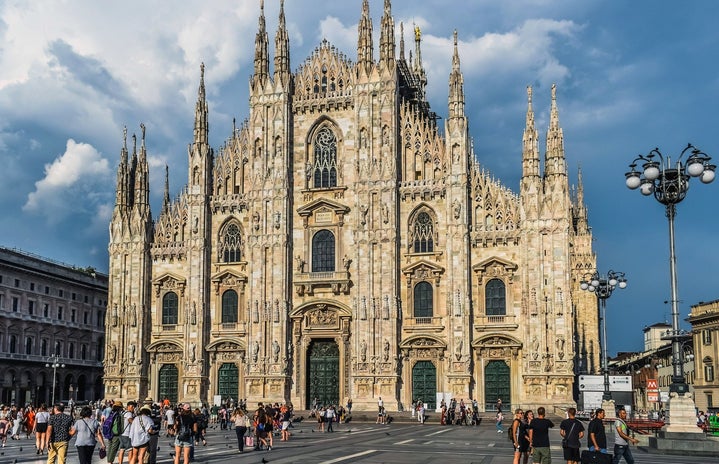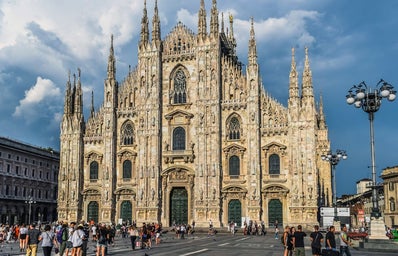Almost two weeks ago, my long-time dream of studying abroad finally became a reality. After over a year of preparation – from the tedious process of getting a visa to trying to fit four months of my life into a suitcase and carry-on – I finally arrived in Milan, Italy. I chose Milan because of the nature of the city; it is a fast-paced, bustling city, and the business and fashion capital of Italy (not to mention the world capital of fashion twice a year). Yet, at the same time, if you search for it, you’ll discover the hidden classic beauty of Milan: quaint courtyards and balconies, classy cafés, and everything else that comes to mind when you think of Italy. Although I’ve only been in Milan for a couple of weeks, I’ve noticed some key differences in the culture of Italians, and Milanese specifically, vs. Americans. There are so many I could list, but here are a few to get a basic idea:
Time
Italy in general has a slower pace of life than the U.S., where punctuality is typically seen as very important. Italians are often late. In my experience so far, there’s no such thing as “a quick lunch” or “just stopping by the store to pick up a couple things.” Italians prefer to take their time with almost everything, which can be frustrating at times for someone like me, who likes to follow a strict schedule and plan everything out. This is probably the most difficult change to adjust to. While it’s true that Milanese are generally busy people, that doesn’t mean that they don’t like to enjoy life and take things one step at a time.
Food
Similar to the time aspect of Italian culture, meals are usually eaten in smaller portions throughout the day as opposed to just three main meals in the U.S. Not only that, but lunch and dinner tend to follow a specific structure and sequence of meals: a starter, then the first course, second course, side dish, and finally, a dessert to top it off. You can skip a course, but you must follow the sequence. Breakfast is typically smaller than a traditional American breakfast. You won’t find your favorite eggs, bacon, and pancakes here (or at least not nearly as much). The most common breakfast, or colazione, consists of coffee or a latte, and a croissant or another baked good. The coffee is often served in a very small cup in the form of a strong espresso shot. There are also certain social rules for eating. For example, it’s practically a sin here if you order a cappuccino after noon. Along with these rules, most shops and restaurants close around 2:30 or 3pm, and reopen around 7pm. This has also been a difficult adjustment. Sometimes, I want to grab a bite to eat after my class, which ends at 2:15pm, but many places around me are closed until dinner, which is also a couple hours later than the U.S. Eating out also costs less than in the U.S., so I find myself going out a lot more than I would at home. The first night, I ordered a full margherita pizza for four euro, which would be upwards of $15 or more at a typical Italian restaurant in America. My favorite time to eat is probably aperitivo, which is sort of like a pre-dinner social time where you can order a drink and enjoy some small bites with friends.
Dress
This one might be influenced by the fact that I’ve spent nearly everyday in Milan, the capital of fashion, but I think it can go for most of the rest of Italy. Italians generally dress more formally than in the U.S., across all different occasions. Running to the grocery store? In the U.S., throwing on a hoodie and leggings might be socially acceptable, but here in Milan, you’ll see both men and women dressing a tad more formally for even small errands. Another thing to note: I’ve seen more dogs in coats in the past two weeks than the previous 20 years. Walking around the city, it’s common to see older Italian women dressed in fur coats and stylish scarves to run errands. For me, it’s been nice to try out a new wardrobe here instead of the more casual outfits that I typically wear at Bentley. It makes you feel better to dress up, even if only adding an accessory or trading white sneakers for black boots.
Transportation
For the most part, using public transportation is more common in Italy than in the U.S., where much of the population lives in houses, especially in suburban areas. Here, many people live in apartments for much of their lives, so they are used to sharing spaces. As a residential student at Bentley, the 30-minute commute to class every morning has been an adjustment for sure, but I like to make it more interesting by listening to Italian music or podcasts. I have to sit through that time anyway, so might as well take advantage of it by learning something. Otherwise, I’ll usually call my family or friends on the commute back home. Google Maps has been a lifesaver for me, especially in the beginning when I was unfamiliar with the ATM, the public transportation system of Milan.
Environment
Recycling is very important in Italy, and virtually everyone seems to recycle, whereas it is merely encouraged in the U.S. In both public and private spaces, there are usually different bins for different categories of items, such as glass, paper, and plastic. To be honest, I’m not used to always sorting out my trash back at home, so it’s motivated me to be more environmentally conscious when I return to the States.
Communication
Italians tend to keep less personal space between themselves and others and use more expressions than Americans. The latter is sort of a stereotype that many Americans have of Italian people, but it’s somewhat true. You can practically have a whole conversation with an Italian without saying a single word. Some gestures are pretty useful, especially if you’re unfamiliar with the language and need to quickly get your point across. Here, I’ve been learning some key phrases when going out, such as how to order at a restaurant, check out items at the store, politely pass through a crowd, etc.
While there are so many more idiosyncrasies of Italian culture that I could share, hopefully this list gave you an idea of what the adjustment has been like. The culture shock hasn’t been as extreme as I expected, but some differences, like the slower pace of life and stores being closed at strange hours have been a challenge. Ultimately, I try to see it all as a way to increase awareness and appreciation of Italian culture. I’ve also become more aware of my biases as an American and things that I’ve taken for granted, like having greater access to still water and easily finding restrooms. But don’t get me wrong, I love it here so far and I’m so glad I made the decision to study abroad, despite the natural hurdles it comes with. If you’re considering going abroad and are hesitant or nervous about culture shock, don’t worry! It all gets better with time, and you’ll learn to appreciate both what you have at home and what you’ll experience in whatever city you find yourself in!


